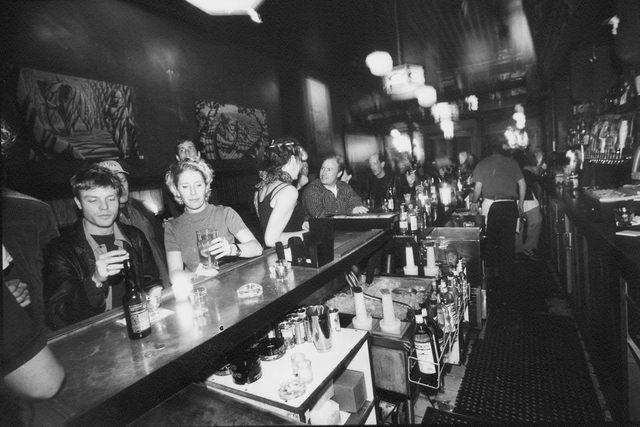Minnie Driver spends much of The Governess clothed in what can only be described as a big black leather truss. Did I say truss? I meant dress—big black leather dress.
The Governess
directed by Sandra Goldbacher
starring Minnie Driver, Tom Wilkinson
now playing at Harvard Exit
Driver’s outfit, as you can see, puts the viewer in mind of sex. Her character, Rosina, is a wealthy young Hassidic Jew who, when her family falls on hard times, dons the name Mary Blackchurch—and the aforementioned garment—and heads off to the Isle of Skye to become a governess. Throughout her governatorial (I’m sure that’s wrong) stint, she wears the dress, which I find I can go no further without describing. It’s a tight black leather bodice with long black leather sleeves and then a full, yes, black leather skirt. Indoors, Rosina/Mary wears it with just her modesty for decoration. Outdoors, she wears it with—what else?—a big black leather coat.
Once she is ensconced in her job, she discovers that Cavendish (The Full Monty‘s Tom Wilkinson), the father of the house, is experimenting with photography. She takes time off from her charge, Clementina (played with aplomb by Fairy Tale‘s Florence Hoath), and helps the father in his studio. I think we all know where this is headed. The first day she works for him, he cinches her into a leather apron, wrapping the leather sash tightly around her wasp waist, tying it in a firm leather bow at the back.
I only linger in my description because director Sandra Goldbacher lingers so in her direction. It must mean something, all this leather. Or then again, maybe it doesn’t. The leather problem is emblematic of the larger problem with the film: While Goldbacher sets many an intriguing element spinning in its first half-hour, none of them comes to rest with any discernible meaning attached to them. Like the dress, the photographic experiments between governess and employer would seem to be embedded with some kind of symbology of power and sexuality. Or something. Unfortunately, about two-thirds of the way through the film, we discover that Goldbacher has no more idea about what this something is than we do.
Even more confusing than the film’s proliferation of weighty images with no attendant meaning is the simple problem of tone. For that first half-hour, Goldbacher’s direction seems to travel in lockstep with Minnie Driver’s goofy, yet intimidatingly witty, performance. This is the Minnie Driver who donned those big green plastic glasses in Good Will Hunting and still looked like a brain, the actress who seemed to fly through the air as she flung herself around her bedroom in Grosse Pointe Blank. She’s a quicksilver girl, a kind of witch of the cinema, a heroine who could cut you with just her raised eyebrow and you’d still come back for more. Rosina/Mary describes the green, Northern landscape of her new home to her sister with the kind of intelligent shorthand that marks the best of Goldbacher’s screenwriting: “Anodyne, hostile countryside. How I detest it. Isle of Skye. Sounds romantic. Gothic even.”
This gentle, self-reflexive send-up of the film’s gothic overtones is emphasized by the family that Rosina/Mary finds herself serving. The fine British stage actress Harriet Walter brings a wide-nostriled consumptive deliciousness to her role as the sexually repressed Mrs. Cavendish. The Cavendishs’ son Henry, played by pale-skinned, full-lipped Jonathan Rhys Meyers (looking like a member of the Verve), flings himself around in despair, having been sent down from Oxford for frequenting opium dens. And young Clementina has a sick imagination and a sharp, nonsensical wit that make her seem like a younger version of Rosina herself. In between her lessons, she flays her dolls and tells her how very naughty they’ve been. In a telling gesture, she names one doll after her governess: “Have you been naughty, Mary Blackchurch?” she asks the doll spankingly. “You will be punished. I’ll see you’ll never learn to polka.” (At least that’s what I heard.)
Once the sexy bits start, this off-kilter humor is abandoned for pure melodrama—the film suddenly stops sending up its gothicity and revels in it. Cavendish passionately adores Rosina/Mary till she dares to turn the camera back onto him. Then he abandons her cruelly. The Minnie we see now, clinging to her rejecting lover, reminds us not of the actress but of the strange celebrity we read about in the movie mags, obsessing over her breakups with Matt Damon and Foo Fighters drummer Taylor Hawkins. The movie has changed; we don’t recognize it anymore. And we don’t like what we see.
Along with the wit and the elusive charm of the film, the dress’s power is cast aside as well. The dress had promised us a disruptive view of sexuality; watching Minnie stride around the moors in her modern yet old-fashioned coat, we waited to see what new yet old forms of sex would be presented to us. Yet while the sex in this film is fairly explicit, it’s never very sexy or even very interesting. The dress floats outside the rest of the film, mysterious and alluring, an unkept promise, signifying what should have been.





